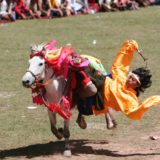Losing your patience can teach you a lot. You just have to listen. In fact, it may be that the best side-benefit of practicing patience is what you learn when you lose it. I was talking with a friend today about expectations (which, if you’re like me…
I’ve been talking about the three definitions of patience, or kshanti, and the third is patience as clarity. This is by far the hardest one to grasp, and to practice. Others describe it as the acceptance of truth. Patience as clarity asks us to see the world…
As I mentioned in an earlier post, the word kshanti can be described as three types of patience. The first is gentle forbearance. The second is enduring hardship. Patience and endurance have a deep connection, not just in practice but in the words that describe them both.…
One week into my month of practicing patience, here’s what’s come up for me: I’m learning to be patient with my sadness. It’s not what I expected to emerge. (I thought the most obvious thing would be my own impatience!) But after a week of midterm…
Kshanti, or patience, is described in three unique ways. Today I want to talk about patience as gentle forbearance. Gentle forbearance is probably what we most readily think about when we think about patience. It’s that quality of being non-reactive, of breathing deep instead of raging…
For the month of November, I’ll be practicing the paramita kshanti, which means patience. It is also translated as forbearance. Kshanti is the quality of being steadfast, regardless of what’s happening around you. It’s steadiness and endurance and has the sense of a kind of peaceful…







